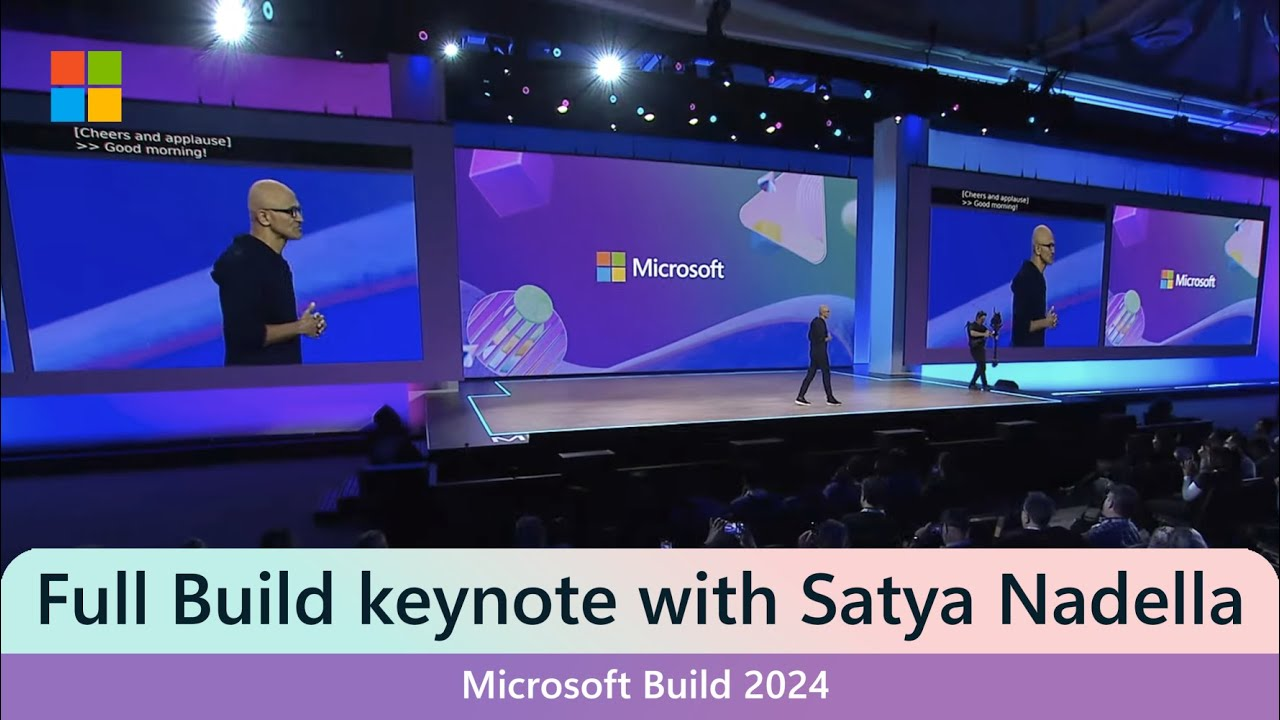
The Microsoft Build Keynote marks a monumental event as it showcases the tech giant’s vision for the future of technology. In this year’s address, CEO Satya Nadella elaborated on the importance of AI design principles, emphasizing how trust in technology is paramount amid the rapid evolution of Artificial Intelligence. Microsoft Azure plays a crucial role in this transformative journey, offering developers the tools necessary to innovate with confidence. Furthermore, Nadella emphasized a commitment to collective responsibility, calling for ethical practices in the development of technology that will ultimately enhance user experiences. The keynote resonated with a broader narrative about empowering communities through tech, reinforcing Microsoft’s foundational ethos in a rapidly changing digital landscape.
This annual developer conference, known as the Microsoft Build Keynote, serves as a pivotal platform for presenting the company’s forward-thinking objectives. With a keen focus on ethical guidelines in technology, the Chief Executive Satya Nadella outlined how trust and responsible design in AI are becoming increasingly crucial. Utilizing innovative frameworks through Microsoft Azure, the keynote underscored the collaborative effort required for developers to navigate the complexities of modern technology. The session also highlighted the collective ethical obligations of the tech community, echoing sentiments of accountability and empowerment. In essence, this gathering is not just about showcasing the latest advancements but also about fostering a dialogue around sustainable and trustworthy technological progress.
The Evolution of Microsoft Through Keynote Presentations
Watching the Microsoft Build keynote this morning offered a unique opportunity to reflect on how far Microsoft has come in the past few years. Satya Nadella’s leadership has shifted the company’s culture and priorities, focusing on ethical technology and trust as the foundation of their products. This transformation can be viewed alongside the evolution of AI design principles, reminding us of the significance of creating technology that serves humanity. Through keynote presentations, the message is clear: Microsoft is dedicated to shaping a future where technology enhances human capabilities, grounded in responsible design and collective responsibility.
Nadella’s emphasis on collective responsibility resonates strongly with the audience, showcasing Microsoft’s commitment to inclusivity and trust in technology. As the keynote revealed, this isn’t just about products or services like Microsoft Azure; it embodies a philosophy where ethical considerations are at the forefront of every technological advancement. The evolution of these presentations is not just about showcasing new features; it’s about creating a narrative that aligns the technological advancements with human values, ensuring that trust is woven into every layer of the company’s offerings.
Trust as the Cornerstone of Microsoft’s Strategy
Central to Nadella’s message during the Build keynote is the concept of trust. In today’s rapidly evolving technological landscape, trust acts as the bedrock of successful innovation. Microsoft recognizes that users must feel confident in their technological tools, especially as they integrate AI into their daily lives. The keynote highlighted this with the introduction of innovative services designed to enhance user experiences while maintaining the core principle of trustworthy interactions. From AI-driven tools that increase productivity to cloud solutions like Microsoft Azure that emphasize security, trust is a theme that runs deep.
Furthermore, trust in technology is not merely a marketing gimmick for Microsoft, but rather a fundamental design principle that guides their strategic decisions. Nadella’s comments on the importance of considering trust in every facet of their development process demonstrate a commitment to delivering reliable products. As organizations adopt AI solutions, it becomes essential that these tools not only function effectively but also foster a sense of security and accountability among users. This collective responsibility permeates Microsoft’s innovation process, ensuring that users can rely on their technology.
With initiatives like ElectionGuard, Microsoft illustrates how trust translates into tangible actions that prioritize user security and transparency. Such programs not only enhance credibility in democratic processes but reflect a broader commitment to behave as a responsible corporate entity in the technology landscape. By placing trust at the center of its strategy, Microsoft seeks to empower users, fostering a partnership that extends beyond mere product utility.
AI Design Principles Guiding Microsoft’s Future
As Microsoft advances in the AI space, the importance of ethical AI design principles becomes ever more apparent. Reflecting on the concepts presented during the Build keynote, it is clear that Microsoft is committed to responsible innovation. Nadella’s mention of AI design principles not only echoes the need for ethical considerations but also reinforces a framework that prioritizes user autonomy and respect within AI applications. This approach aims to guide developers in creating intelligent systems that work for people rather than against them.
In practical terms, integrating these design principles means fostering a collaborative environment where AI systems are developed with user feedback and social values in mind. Nadella’s assertion that ‘we need a multi-agent world’ highlights a vision for AI that thrives on openness and interoperability. By ensuring that AI systems can communicate and collaborate seamlessly, Microsoft empowers developers to leverage diverse datasets and insights, ultimately leading to more robust outcomes that benefit society as a whole.
Collective Responsibility in Technological Development
Collective responsibility was a focal point during the Microsoft Build keynote, illustrated by Nadella’s commitment to ensuring that technology serves the common good. The call for collective responsibility emphasizes that technological development is a shared endeavor; all stakeholders must consider the broader impacts of their innovations. Microsoft stresses that as stewards of technology, developers and organizations must prioritize ethical considerations in their pursuits, ensuring that advancements in AI and cloud computing benefit everyone.
The concept of collective responsibility also translates into Microsoft’s community initiatives and partnerships. By developing tools like Azure to support secure voting systems, Microsoft showcases how technology can democratize processes and foster trust among users. This is just one example of how the company aims to involve its community in the product development lifecycle, ensuring that voices from various backgrounds are considered. Thus, collective responsibility isn’t just a theoretical notion; it is a guiding principle that shapes the company’s direction and defines its impact on society.
Microsoft Azure: A Foundation for Trust and Innovation
Microsoft Azure is not merely a cloud platform; it represents an ecosystem built on the foundation of trust and innovation. During the Build keynote, Azure was highlighted as a crucial component of Microsoft’s strategy for embracing new AI-driven technologies. This emphasis on Azure underscores the importance of reliable infrastructure in fostering innovation while maintaining user trust. As developers increasingly rely on cloud services, having a secure and ethically sound platform is paramount.
Furthermore, Azure’s capabilities align closely with the AI design principles discussed by Nadella. By providing developers with the tools to create transparent, accountable applications, Azure embodies Microsoft’s commitment to responsible AI. The integration of features like secure AI development kits empowers organizations to build applications that prioritize user privacy and data security, fostering a climate conducive to trust and ethical development. As the landscape of technology continues to evolve, Azure stands at the forefront, illustrating how trust and innovation can work harmoniously.
Empowerment as a Core Value at Microsoft
Empowerment emerged as a central theme during the Microsoft Build keynote, consistent with the company’s mission to put ‘a computer on every desk and in every home’. This principle has evolved into a broader focus on empowering individuals and organizations through technology. Nadella’s vision illustrates how Microsoft is committed to offering tools that enhance capabilities, enabling users to accomplish more through their work and daily lives. The emphasis on empowerment reflects an understanding that technology should not only serve as a tool but as a means of facilitating growth and positive change.
The notion of empowerment in tech also intersects with collective responsibility, as Microsoft encourages users and developers to utilize their platforms to create solutions that address societal challenges. By focusing on building accessible technology that promotes inclusivity, Microsoft aims to bridge gaps and bring people together in the digital sphere. Such initiatives, whether through AI-driven education tools or services that enhance workplace collaboration, encapsulate Microsoft’s commitment to user empowerment as a fundamental part of their overarching design ethos.
The Future of AI: A Collaborative Endeavor
The keynote emphasized that the future of AI is a collaborative endeavor, where innovation thrives on partnerships and shared insights. Nadella’s reference to an ‘open assistant future’ underscores the necessity for a multi-faceted approach to AI development. This highlights Microsoft’s ambition to create an ecosystem where intelligent agents work cohesively rather than in isolation, allowing for enhanced functionality and user experience. Embracing collaboration is vital to unlocking the full potential of AI technology, ultimately making it more accessible and efficient for everyone.
In practical terms, this collaborative spirit can be seen in initiatives such as the Open Data Initiative, which encourages interoperability among disparate systems. By fostering communication between different technologies, Microsoft aims to enhance the overall effectiveness of AI solutions. This approach empowers developers to leverage diverse datasets, driving better outcomes and promoting innovation across various applications. As this vision for an integrated AI ecosystem unfolds, it will shape the future of technology in ways that resonate with users and developers alike.
The Impact of Microsoft Build Keynote on Developer Community
The Microsoft Build keynote not only showcased the company’s technological advancements but also reinforced its commitment to the developer community. By emphasizing trust, collective responsibility, and ethical AI design principles, the keynote aimed to inspire developers to align their practices with these core values. With Satya Nadella at the helm, the message is clear: developers have a critical role in shaping the future of technology, and their contributions are essential in creating a trustworthy digital environment.
Moreover, the impact of the keynote extends beyond just the announcements made; it serves as a call to action for developers to engage with these principles and integrate them into their own projects. By promoting ethical technology development and encouraging collaboration, Microsoft aims to cultivate a thriving community that prioritizes innovation, user trust, and accountability. As the developer community continues to expand, the influence of the Build keynote will undoubtedly resonate, driving a shift toward responsible, impactful technology.
Frequently Asked Questions
What were the key themes discussed by Satya Nadella during the Microsoft Build Keynote?
During the Microsoft Build Keynote, CEO Satya Nadella emphasized three fundamental design principles: trust, collective responsibility, and empowerment. He highlighted the importance of integrating trust into technology, particularly as artificial intelligence continues to evolve, alongside the significance of collective responsibility in ensuring ethical AI development.
How does Microsoft Build Keynote address the idea of trust in technology?
The Microsoft Build Keynote addressed trust as a cornerstone principle in technology development. Satya Nadella stressed that building trust into every facet of technology, especially in AI and cloud services like Microsoft Azure, is crucial for developers and end-users alike.
What role does collective responsibility play in the announcements made at Microsoft Build Keynote?
Collective responsibility was a central theme of the Microsoft Build Keynote, particularly with the introduction of tools like ElectionGuard, which aims to enhance the security and verifiability of voting systems. This reflects Microsoft’s commitment to ethical practices in technology and its impact on society.
What advancements in AI were showcased during the Microsoft Build Keynote?
The Microsoft Build Keynote showcased several advancements in AI, notably the Azure Speech Service. This technology demonstrated accurate transcription of meetings and speaker identification, reinforcing the importance of trust and reliability in AI-driven applications.
How does Microsoft Azure contribute to the overall message presented in the Microsoft Build Keynote?
Microsoft Azure is positioned as a foundational platform that supports the ethical principles discussed in the Microsoft Build Keynote. By providing infrastructure for trustworthy AI applications and promoting collective responsibility, Azure exemplifies the integration of these core values in practical technology solutions.
What is the significance of AI design principles mentioned in the Microsoft Build Keynote?
The AI design principles discussed at the Microsoft Build Keynote highlight the importance of trust and empowerment in the development of intelligent systems. These principles guide how Microsoft aims to build products that not only function effectively but also prioritize the ethical implications of AI in society.
What vision did Satya Nadella propose for the future of AI at the Microsoft Build Keynote?
Satya Nadella proposed a vision for an open and interoperable AI landscape during the Microsoft Build Keynote. He emphasized the need for a multi-agent ecosystem where data can freely enhance outcomes across different systems, aiming for a collaborative approach in developing intelligent agents.
How does the concept of empowerment relate to Microsoft’s goals as presented in the Build Keynote?
Empowerment was framed as a core goal in the Microsoft Build Keynote, echoing the company’s founding mission to put a computer in every home. The keynote reinforced that through trust and innovative technology, Microsoft aims to empower users and developers to achieve greater outcomes in their endeavors.
| Key Points | Details |
|---|---|
| Microsoft Build Keynote Overview | The keynote reflects on Microsoft’s evolution over five years, emphasizing themes like trust and collective responsibility in design. |
| Influence of Asimov’s Laws of Robotics | Nadella’s discussion parallels Asimov’s laws, highlighting the importance of foundational principles in technology. |
| Design Ethics Embedded in Technology | Microsoft’s design philosophy includes trust and responsibility, essential for AI and cloud platform development. |
| Empowerment as a Core Principle | The keynote echoed the company’s mission of empowerment, with trust deeply embedded in products. |
| Azure Speech Service Demonstration | Highlighted technology that accurately transcribes meetings and identifies speakers. |
| ElectionGuard and Democracy Initiatives | Introduced a secure voting SDK as part of Microsoft’s commitment to trustworthy systems. |
| Open Data Initiative and AI | Promotes interoperability and enhances outcomes by integrating data across systems. |
| Future of Personal Assistants | Nadella advocates for a multi-agent approach to AI-powered digital assistants. |
Summary
The Microsoft Build Keynote underscored the company’s commitment to strong design principles, emphasizing trust and collective responsibility as essential tenets of their technology. As articulated by CEO Satya Nadella, these principles guide Microsoft’s innovations in AI and cloud solutions, ensuring that as they empower users, trust remains at the forefront. Through key examples such as the Azure Speech Service, ElectionGuard, and the Open Data Initiative, the keynote highlighted a future where technology enhances daily life sustainably and ethically. Microsoft’s focus on building a multi-agent ecosystem further illustrates its vision to lead in the realm of intelligent interactions. The keynote not only reflects Microsoft’s past achievements but also positions them strongly for the future of technology.



